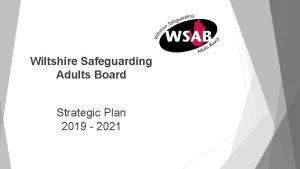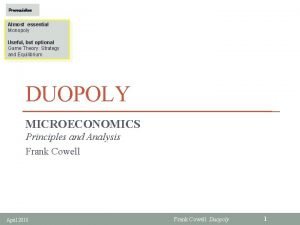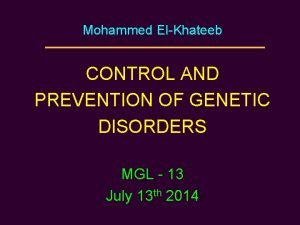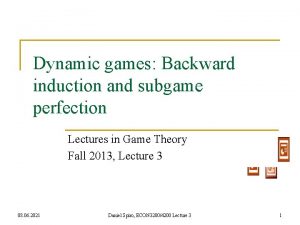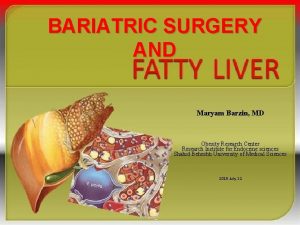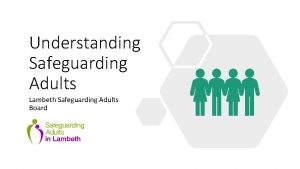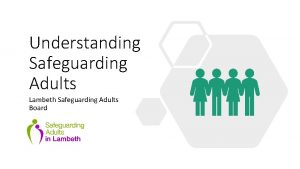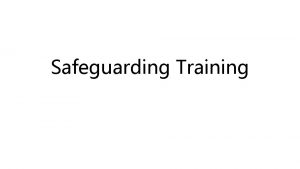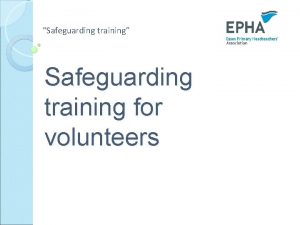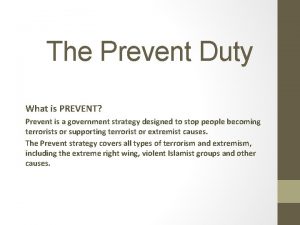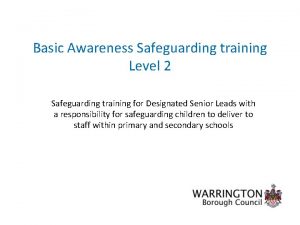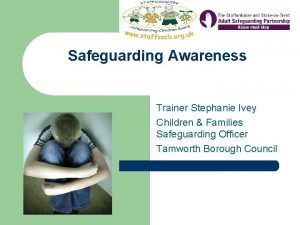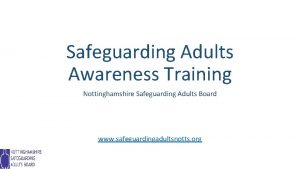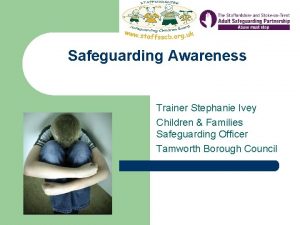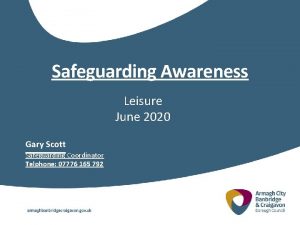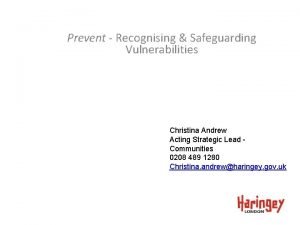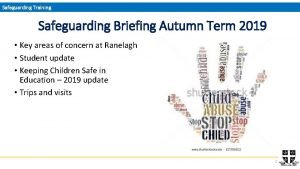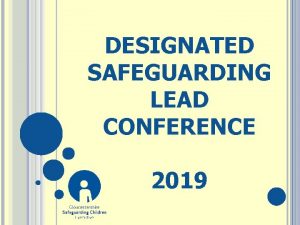Safeguarding Prevent Awareness 2019 Andrew Nash Introduction Uo





































- Slides: 37

Safeguarding & Prevent Awareness 2019 Andrew Nash

Introduction Uo. B and ahs and all employees have a duty of care to safeguard the welfare of all children and adults at risk* AND to have due regard to prevent people from being drawn into terrorism. We need your help to do this. This short course will help you understand more about your role in regard to Safeguarding and Prevent responsibilities : • Identifying abuse • Recognising signs • Have a basic understanding of the factors which can lead to radicalisation • Knowing what and how to report concerns

It’s ok to not feel ok! • Confidentiality • Leaving the session • Speak to me after if you need to

Safeguarding: The Law • Safeguarding is protecting children or adults at risk from abuse or neglect: • The Safeguarding Vulnerable Groups Act came after 2 young girls were murdered by their school caretaker. • It was passed to help avoid harm, or risk of harm, by preventing people who are deemed unsuitable to work with children and vulnerable adults from gaining access to them through their work.

Children & Adults at risk Definitions A Child is defined as: a person under 18 years of age (The Children Act 1989) Definition of an adult at risk is: An adult at risk is any person who is aged 18 years or over and at risk of abuse or neglect because of their needs for care and or support.

6 Principles of Safeguarding Empowerment People are supported and encouraged to make their own decisions and informed consent. Prevention It is better to take action before harm occurs. Proportionality The least intrusive response appropriate to the risk presented. Protection Support and representation for those in greatest need. Partnership Services offer local solutions through working closely with their communities. Communities have a part to play in preventing, detecting and reporting neglect and abuse. Accountability and transparency in delivering safeguarding.

Who is responsible for Safeguarding? • Safeguarding and promoting the welfare of children is everyone’s responsibility. • Everyone who comes into contact with children and their families and carers has a role to play in safeguarding children. • We all have a due regard to Prevent for our students, colleagues and any of our guests

Who is responsible for Safeguarding? All staff members should be aware of systems within their place of work which support safeguarding and these should be explained to them as part of staff induction. This should include: • the child protection or safeguarding policy; • the staff behaviour policy (sometimes called a code of conduct) • the role of the designated safeguarding officer (DSO). • Reporting mechanisms for raising a concern on either Safeguarding or Prevent issues

Safeguarding challenges in ahs Student accommodation 110 new undergraduate under 18 students living with us during 2018 -19 • Most will turn 18 at some point during the year. • Spread out across most buildings 28 International Foundation Year under 18 students living with us during 2018 -19 • All living at John Wood • Most remain under 18 for most of their time with us. Students in general arrive from many different cultures and backgrounds from across the globe

Safeguarding challenges in ahs Adults at risk • Students living with us or studying on campus with disabilities • Students living with us or studying on campus with additional support needs (anxiety/depression, ASD) • Fitness to study policy • May not have been disclosed prior to enrolling • Adults at risk not “listed “ as such • International students with a varied religious, political, social backgrounds • Commercial guests anonymity

What is abuse and neglect? • Abuse and neglect are forms for maltreatment • Both can involve inflicting harm or failing to prevent harm • Children and adults maybe abused in a family, institutional or community setting Children Act 1989

Types of abuse • Physical • Sexual • Emotional & Psychological • Neglect

Leaving a child on their own for an extended period of time Physical Abuse Neglect Sexual Abuse Emotional Abuse Subjecting a child to sexual materials Hitting or kicking someone Using threats & taunts

Types of abuse, adults: Financial – Theft, Fraud, scamming, Preventing a person from accessing their own money, Pressure/threats in connection with loans/wills/inheritance etc. , Arranging less care to save money/maximise inheritance, Denying assistance to manage financial affairs, Denying assistance to access benefits, False representation, using another person's bank account, cards or documents… Self-neglect/Neglect - Lack of self-care so that it threatens personal health and safety, Neglecting personal hygiene, health or surroundings, Inability to avoid self-harm, Failure to seek help/access health or social care needs, Inability or unwillingness to manage one’s personal affairs… Failure to provide/allow access to food, shelter, clothing, heating, stimulation/activity, personal or medical care, Failure to administer medication as prescribed, Refusal of access to visitors, Ignoring individuals’ cultural, religious or ethnic, educational, social and recreational needs, Ignoring or isolating the person, Preventing the person from making their own decisions, Preventing access to glasses, hearing aids, dentures, etc. , Failure to ensure privacy and dignity

Types of abuse, adults: Adults at risk may also be vulnerable to further types of abuse, such as: Discriminatory - Unequal treatment based on one of the 7 ‘protected characteristics’ under the Equality Act 2010), Verbal abuse, derogatory remarks or inappropriate use of language, Harassment or deliberate exclusion, Denying basic rights to healthcare, education, employment and criminal justice, Denying access to communication aids, not allowing access to an interpreter, signer or lip-reader Organisational or Institutional - Discouraging visits or involvement of relatives/friends, Run-down or overcrowded establishment, Authoritarian management/rigid regimes, Lack of leadership/supervision, Insufficient staff or high turnover resulting in poor quality care, Abusive and disrespectful attitudes towards people using the service, Inappropriate use of restraints, Lack of respect for dignity and privacy, Failure to manage residents with abusive behaviour, Not providing adequate food and drink, or assistance with eating, Misuse of medication, Failure to respond to abuse appropriately, Interference with personal correspondence or communication, Failure to respond to complaints

Threats posed to children and vulnerable adults

https: //www. nspcc. org. uk/preventingabuse/child-abuse-and-neglect/child-sexualabuse/sexual-abuse-facts-statistics/

Child Exploitation • Young people under the age of 18 – encouraged/forced into a sexual relationship or situation by an adult. • Often offered something in return for performing sexual acts e. g. alcohol, cigarettes, phones, gifts, money, drugs Abuse can happen anywhere, at any time, but… • Parks, shopping centres, restaurants, gyms, leisure centres, Hotels, Hostels, pubs, bars & clubs are common places for this to take place • Premises licences holders and their managers are responsible for control measures for the protection of children under Licensing Act 2003. • Police also have powers under section 116 of the Anti-social Behaviour, Crime and Policing Act 2014 to serve notice when an officer reasonably believes a premises has or will be used for the purposes of: a) Child sexual exploitation b) Conduct that is preparatory to, or otherwise connected with, child sexual exploitation

Trafficking • Children and young people who are victims of sexual exploitation are also vulnerable to trafficking across cities and counties within the UK as well as internationally for the purposes of sexual exploitation. • Trafficking is the illegal trade of human beings for the purposes of sexual exploitation. • It is punishable to up to 14 years in prison • Failure to comply with our legal responsibilities can lead to: Financial/reputational damage Revocation of licenses Prosecution

Safeguarding Exercise Situation You often hear your neighbours shouting late at night. They have a baby and when you have seen the baby she looks clean and nicely dressed. A 7 Year old girl, who has learning difficulties, regularly gets a lift home on her own from her choir teacher after attending the choir club at school. A 14 year old girl goes out clubbing on most Fridays and comes home in the early hours. She appears to have a boyfriend who is much older, he buys her expensive presents and stays over. Rank 0 -4 Reasons

Prevent: The Law • Or to prevent those vulnerable to being drawn into terrorism: • Section 26 of the Counter-Terrorism and Security Act 2015 places a duty on certain bodies, such as ours, to have "due regard to the need to prevent people from being drawn into terrorism". What does that mean for us? • Recognise factors that can contribute to a student’s* vulnerability • Identify Prevent related safeguarding concerns • Seek advice and report

Children & Vulnerable adults? Definitions Extremism: “The vocal or active opposition to British values, including democracy, the rule of law, individual liberty and mutual respect and tolerance of different faiths and beliefs. We also include in our definition of extremism calls for the death of members of our armed forces, whether in this country or overseas” (Report of Government Task Force on Extremism) Radicalisation: “This refers to the process by which a person comes to support terrorism and forms of extremism leading to terrorism. A radicaliser is an individual who encourages others to develop or adopt beliefs and views supportive of terrorism and forms of extremism leading to terrorism” (Prevent Strategy)

Who is responsible for Prevent? • We all have a due regard to Prevent for our students, colleagues and any of our guests • We should all be aware of the role of the designated safeguarding officer (DSO). • Reporting mechanisms for raising a concern on either Safeguarding or Prevent issues

Prevent – Contest 3. 0

Radicalisation - How does it start?

Process of Radicalisation Prevent WRAP Interview 1

Process of Radicalisation "This is My Story" A&S Police Video

Domestic Extremism • Football Lads Alliance (FLA) According to The Times, "the movement was set up as a self-proclaimed 'anti-extremist‘ movement" but has increasingly become associated with far-right politics and far-right activists. • English Defence League (EDL) Far right Islamaphobic organisation • Gen ID (Originated in France 2012) Links to Tommy Robinson


Exercise • Understanding how people are drawn to terrorist ideologies & how they remain bonded to the causes helps us to identify ways to intervene & support them. In groups: 1. List some of the signs / behaviours that you think could make someone vulnerable to being groomed for the purpose of being drawn into terrorism 2. List a few external factors that could cause someone to remain bonded to a cause (extremist ‘narrative’) 3. List some of the signs/behaviours that you think may indicate that someone is possibly subject to some form of abuse

What to do if Someone alerts/confides in you… • Allow them to speak without interruption and accept what they have to say • Be understanding and reassuring but do not give your opinion • Let them know you will try to offer support but that you must pass the information on • Inform someone immediately • Write careful notes about what was said (as accurate as possible), but do notes after conversation • Pass those notes onto the appropriate persons (line manager, the DSO or Security )

Reporting concerns Record Safeguarding & Prevent concerns in the same way: 1. Name of individual; 2. Date; 3. What was discussed / disclosed / seen; or what your concerns are. Provide these details to either: Departmental Safeguarding officer – Matt Waldron/Jane Loveys Student Services ext. 4321 (staff advice line) Laura Palmer ext. 5398 or the Prevent Lead Mark Humphriss ext. 6212

Reporting If you’re uncomfortable or suspicious of an adult’s (or child’s) behavior, but there is not proof, it’s best to do nothing… TRUE FALSE False. We’ve discussed our duty of care, how abuse can occur anywhere and how to recognise the signs. Even if you are uncertain it’s better to report any concerns to your line manager, security or the Departmental Safeguarding Officer in the first instance, depending on the situation.

Keeping yourself safe Know the ‘rules’ of safeguarding and stick to them in order to ensure that your actions are not misconstrued. Abide by our ahs staff Code of Conduct • Social networking • Gifts • Photos • Drugs & alcohol • Physical contact • First aid

Questions ?

Other resources • http: //www. bath. ac. uk/corporate-information/modern-slavery-and-human-traffickingstatement/ • http: //www. safeguardingchildrenea. co. uk/safeguarding-news/keep-them-safe/ • https: //www. gov. uk/government/uploads/system/uploads/attachment_data/file/550 511/Keeping_children_safe_in_education. pdf • https: //www. gov. uk/government/uploads/system/uploads/attachment_data/file/592 101/Working_Together_to_Safeguard_Children_20170213. pdf • University Prevent Policy - http: //www. bath. ac. uk/university-secretary/guidancepolicies/preventpolicy. pdf • SU External Speakers policy – https: //www. thesubath. com/pageassets/newevent/Policy-around-external-speakers-final-180216 -002. pdf • Safe Campus Communities - http: //www. safecampuscommunities. ac. uk/ • A Community Response to Extremism (A&S Police) https: //www. youtube. com/watch? v=w. KEe 3_nm_x 4&feature=youtu. be • Lets Talk About It – Various resources including previous EDL member https: //www. ltai. info/videos/

 Andrew hall safeguarding pro
Andrew hall safeguarding pro Andrew hall safeguarding pro
Andrew hall safeguarding pro Wiltshire safeguarding flowchart 2019
Wiltshire safeguarding flowchart 2019 Cvs privacy awareness and hipaa training answers
Cvs privacy awareness and hipaa training answers Introduction to mental health awareness presentation
Introduction to mental health awareness presentation 3 p's of environmental awareness
3 p's of environmental awareness Andrew ng introduction to machine learning
Andrew ng introduction to machine learning Andrew ng intro machine learning
Andrew ng intro machine learning Andrew ng introduction to machine learning
Andrew ng introduction to machine learning Nash-evenwicht
Nash-evenwicht To my valentine by ogden nash questions and answers
To my valentine by ogden nash questions and answers Pure-strategy nash equilibria
Pure-strategy nash equilibria Teorema de folk
Teorema de folk Equilibrio pareto efficiente teoria dei giochi
Equilibrio pareto efficiente teoria dei giochi Nash evenwicht
Nash evenwicht Almost essential
Almost essential Nash gleichgewicht
Nash gleichgewicht Perineonatologist
Perineonatologist Nash evenwicht
Nash evenwicht Lafadz dari
Lafadz dari Equilibrio de nash
Equilibrio de nash Joan nash
Joan nash Théorie des jeux
Théorie des jeux Game theory cartoon
Game theory cartoon Define optimal strategy in game theory
Define optimal strategy in game theory Chipotle
Chipotle Jelly nash
Jelly nash Esercizi equilibrio di nash
Esercizi equilibrio di nash équilibre de nash
équilibre de nash Equilibrio de nash ejemplos resueltos
Equilibrio de nash ejemplos resueltos Simultaan en sequentieel spel
Simultaan en sequentieel spel Dominant strategy
Dominant strategy Subgame perfect nash equilibrium
Subgame perfect nash equilibrium Adam nash designer baby
Adam nash designer baby Pure-strategy nash equilibria
Pure-strategy nash equilibria Ad1p
Ad1p Var
Var Nash's pyramid
Nash's pyramid


